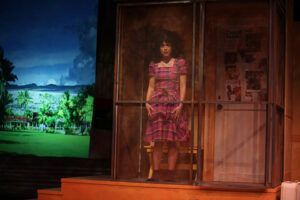In Part 2 of the “Queens Girl” trilogy, Lauren Steele dazzlingly embodies voices out of Africa; “Hamilton” and its hip-hop cousin settle in; “Titus” wraps things up.
 “Queens Girl in the World,” the first work in a trilogy by professor and playwright Caleen Sinette Jennings, introduces us to Jacqueline Marie Butler as she faces the mysteries of adolescence and navigates the cultural shift from her predominantly Black neighborhood in the New York burrough of Queens to the white/liberal/Jewish environment of a private school in the heart of the city. Early in the sequel “Queens Girl in Africa,” which opened last week in a production at Clackamas Rep that’s every bit as vibrant as its predecessor, our teen protagonist, newly arrived in Nigeria with her parents, ponders the next phase of her life: “I was Queens Jackie,” she reflects. “And Greenwich Village Jackie. Who will Africa Jackie be?”
“Queens Girl in the World,” the first work in a trilogy by professor and playwright Caleen Sinette Jennings, introduces us to Jacqueline Marie Butler as she faces the mysteries of adolescence and navigates the cultural shift from her predominantly Black neighborhood in the New York burrough of Queens to the white/liberal/Jewish environment of a private school in the heart of the city. Early in the sequel “Queens Girl in Africa,” which opened last week in a production at Clackamas Rep that’s every bit as vibrant as its predecessor, our teen protagonist, newly arrived in Nigeria with her parents, ponders the next phase of her life: “I was Queens Jackie,” she reflects. “And Greenwich Village Jackie. Who will Africa Jackie be?”
Later, in a brushstroke that feels like foreshadowing of a life chapter to come, Jackie gets cast in a school production of Thornton Wilder’s “The Skin of Our Teeth.” “I play the role of Sabina and discover that if it’s OK to have Sabina in my body, it’s OK to have three different Jackies in my body,” she tells us. “Is acting something I could do seriously?”
Acting is something that Lauren Steele can do seriously. Steele stars in “Queens Girl” as Jackie, and, through Jackie as she tells her story, as more than a dozen other, quite varied, characters. The script calls for quicksilver shifts in accent, affect, mood, language, body language; Steele never lets us see how much work must have gone into it all, so smooth and instant is every transition, so clearly delineated is each new voice and stance.
Jackie – bright, enthusiastic, innocent, curious, emotionally transparent – is narrator and actor in her own tale. But there’s also her mother, Grace (prim expression, soft voice, crisp American-standard diction, careful posture with legs always together, a beleaguered elegance like Lena Horne plopped down in the jungle); her father, Charles, a West Indian doctor (proud to the point of haughty, always an upright stance and a downturned mouth); his father’s boss, George, an exile from South Africa (always smiling, his arms and legs as open as his heart); George’s daughter, Terry-may (her snottiness showing in a cocked hip, habitual hair-twisting, and slang-spiked speech in a colonial-Brit accent); Jackie’s dolt of a geography teacher (an ugly-American type, thumbs tucked into a belt above a belly); Fumilayo, a Nigerian student at Jackie’s school, (alternately worried and buoyant, her voice a bubbling fountain of pidgin English); Godfrey, the Butler’s Nigerian house servant (good-natured but uneasy, shoulders stooped by the twin habits of subservience and labor, brows either raised in suspicion or furrowed in worry about rival tribes); and so on.
(Audiences might need to concentrate to track the dialogue at times, but that’s not because of Steele’s voice work – kudos to dialect coach Kim James Bey, who surely earned her fee – rather, it’s a function of the international community Jackie finds herself in, where one friend flaunts her French fluency and the next says things such as “Eef we fit march, where we dey go?”)
Each characterization also rides the fine line between appearing a person in its own right yet also wearing the colorful cloak of Jackie’s perspective. So vivid are they that, after the show, I overheard someone remarking on what a great mimic Steele is. But of course, it’s one thing to mimic someone, quite another thing to invent someone to mimic.
In any case, all those voices and ways of moving through the world aren’t presented here as a way for an actor to show off. The title “Queens Girl” in the World was a hint: As with that first play, this is a story about who Jackie is but also about where she is, what surrounds and affects her. It’s a coming-of-age story concerned not just with the age of its central character but the age in which that character lives. In each part of her story, Jackie is growing up in three ways at once: into herself, as she learns about her heart, her interests, her abilities; into her social surroundings, as she encounters peers and adults from ever-widening backgrounds and strives for both acceptance and independence; and into a fraught, politically charged world, as parallel narratives of racial/ethnic division and violence play out in America and Africa.
Increasingly, Jackie becomes an irreducible sum of many parts. Thinking of what she misses about America, she mentions Otis Redding and then a bagel with schmear. She starts the play besotted by the Beatles; by the end she’s learned to “dance deep into lowdown juju music.” And through it all she’s forming both a keen consciousness of social justice and political outlook that strives to balance practicality with moral imperative.
In a time when identity has become an abiding concern in our culture, Jennings’ “Queens Girl” plays seem like a particular treasure, examining – without prejudice and with abundant charm – some of the ways identity gets formed, as an ongoing process of both individuation and integration.
In a tearful goodbye at the end of “Queens Girl” in Africa, Grace sends her daughter off to college, telling her, “You know who you are, Jacqueline Marie Butler.”
In the moment, it’s hard to think of a greater expression of praise and love.
(Also see Lauren Steele: “Queens Girl” actress and ‘Nighttime’ singer, Dmae Lo Roberts’ Stage & Studio podcast conversation with Steele.)
Oregon ArtsWatch
Arts & Culture
APRIL 7, 2022 // DRAMAWATCH, THEATER // MARTY HUGHLEY
